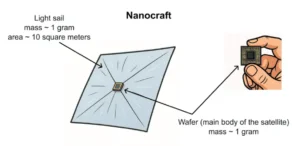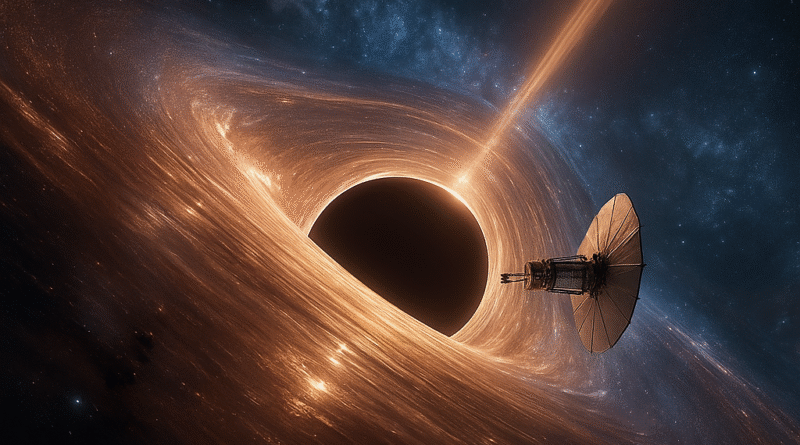Laser-Propelled Spacecraft to Black Hole: 5 Incredible Things You Should Know
Laser-propelled spacecraft to black hole missions might sound like something straight out of a sci-fi blockbuster, but scientists are seriously considering this idea for the future of space exploration. Imagine sending a probe racing through interstellar space at one-third the speed of light—without a drop of rocket fuel!
Why would we do this? Because black holes hold some of the deepest mysteries of the universe. Understanding them could completely change the way we see physics and reality itself.
In this article, you’ll learn:
✔ What a laser-propelled spacecraft is and how it works
✔ Why scientists want to send it to a black hole
✔ The steps involved in the mission
✔ The massive challenges we need to overcome
✔ Why this mission could rewrite science as we know it
What is a Laser-Propelled Spacecraft to Black Hole Mission?
The concept is bold but surprisingly simple. Instead of using chemical fuel like traditional rockets, scientists want to use light to push a spacecraft. This idea is called laser propulsion.

Here’s how it works:
-
A tiny spacecraft, often no heavier than a paperclip, is attached to a super-thin, reflective sail a few meters wide.
-
On Earth, a giant array of high-powered lasers fires beams at the sail.
-
The light pushes against the sail, propelling the spacecraft forward at incredible speeds.
This isn’t just theoretical. The Breakthrough Starshot initiative is already working on similar technology to send probes to Alpha Centauri, the closest star system, in just 20 years.
Now imagine using the same technology to reach a black hole about 20–25 light-years away. If the spacecraft can reach one-third the speed of light, it could make the trip in 60–75 years—a blink of an eye compared to thousands of years with current rockets.
Why Send a Laser-Propelled Spacecraft to Black Hole?
Why go through all this trouble? Because black holes are the ultimate testing grounds for the laws of physics.
Here are the big reasons:
1. Testing Einstein’s Theory of Relativity
Einstein’s theory has passed every test so far, but we’ve never tested it in the strongest gravitational fields. Near a black hole, space and time are warped to extremes. If relativity breaks down anywhere, it’s here.
2. Understanding the Event Horizon
The event horizon is the “point of no return.” If you cross it, nothing—not even light—can escape. But what if black holes aren’t what we think? Some theories suggest exotic alternatives like fuzzballs (from string theory). A close-up mission could settle this once and for all.
3. Searching for New Physics
Could the fundamental constants of nature change near extreme gravity? Could we detect extra dimensions? Questions like these can only be answered by going there.
How Would a Laser-Propelled Spacecraft to Black Hole Work?
This mission would be like nothing we’ve ever attempted before. Here’s a step-by-step look:
Phase 1: Acceleration with Lasers
Powerful laser beams on Earth fire for about 15–20 minutes, pushing the sail and accelerating the probe to nearly one-third the speed of light. At that speed, it could cross the Earth–Moon distance in just a few seconds!
Phase 2: The Interstellar Cruise
After the laser push, the spacecraft coasts silently through space. No fuel, no engines—just pure momentum. The trip to a black hole 20–25 light-years away would take 60–75 years.
Phase 3: Arrival and Split Mission
Once near the black hole, the probe could split into two smaller crafts:
-
Craft A stays at a safe distance and acts as a communication hub.
-
Craft B dives closer to the black hole for high-risk, high-reward experiments.
Phase 4: Science in Extreme Gravity
Possible experiments include:
-
Measuring space-time curvature (Kerr metric test).
-
Observing how signals redshift near the event horizon.
-
Testing if fundamental constants change in strong gravity.
Finally, the data beams back to Earth—a signal that would take 20 years to arrive.
Challenges of a Laser-Propelled Spacecraft to Black Hole Mission
As amazing as it sounds, this mission faces enormous challenges:
1. Technology
-
We need powerful lasers (costing billions) and perfect sails that can handle intense energy.
-
Building a 1 trillion-watt laser array is no small feat!
2. Navigation
Finding the black hole with pinpoint accuracy is tough. A tiny error could mean missing the target by millions of kilometers.
3. Communication
How do you send data across 20 light-years with a probe the size of a stamp? Scientists plan to use the sail as a giant antenna, but it’s still a major hurdle.
4. Time
Even at one-third light speed, the mission would take 80–100 years from launch to final data return. This is a multi-generation project.
Why This Mission Matters for the Future of Space Exploration
If we can do this, the rewards would be historic:
-
Confirming or rewriting Einstein’s theories.
-
Discovering new physics beyond what we know.
-
Proving interstellar travel is possible.
This mission could open the door to exploring other star systems—and maybe one day, other galaxies.
Could We Do This in Our Lifetime?
The good news: scientists believe the required technology—like powerful laser arrays and ultra-light sails—could be ready in 20–30 years. The cost, currently estimated at trillions, might fall to billions as technology improves.
So yes, if a black hole exists 20 light-years away and the tech develops fast, the first laser-propelled spacecraft could launch this century.
Final Thoughts
A laser-propelled spacecraft to black hole sounds like science fiction today. But then again, so did the Moon landing—until it happened.
Will we see humanity take this bold step? Maybe not tomorrow. But one day, a tiny probe might skim past a black hole, sending back answers to questions we’ve asked for centuries.
The paper was published on Thursday (Aug. 7) in the journal iScience.
See 6 Planets Align in the Night Sky This August – Don’t Miss It

